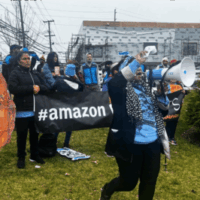Black, immigrant Minnesotans power Amazon’s rapid expansion but bear stark human costs; warehouse conditions marked by racial pay inequities, high turnover, harmful discipline practices
TWIN CITIES, Minn.— As the U.S. grapples with a shortage of workers in the warehousing industry, a new analysis from the National Employment Law Project (NELP) reveals extreme worker injury rates, high turnover, racial pay inequities, and harmful surveillance and discipline practices at Amazon warehouses in Minnesota. The report comes as the corporate giant expands its footprint throughout the country and the state, promising massive growth yet raising grave concerns for workers and communities in Minnesota and beyond.
“Amazon has not lived up to its promise of providing economic security and safe and stable employment. Instead, it has left Minnesotans with injured bodies and unsustainable, dead-end jobs,” said Rebecca Dixon, executive director of NELP. ”It’s time for Minnesota lawmakers and regulators to take action to address the harms to workers, families, and communities caused by Amazon’s operations and hold this company to the standard of safe, family-sustaining jobs and healthy, equitable workplaces.”
The report examines the newest data from the Occupational Safety and Health Administration, U.S. Census, and the Bureau of Labor Statistics for Amazon warehouses in Minnesota, with a particular focus on the two longest-standing Amazon warehouses in the state, located in the Twin Cities suburb of Shakopee. Researchers identified the following job quality problems:
- Quadruple the injury rate of all Minnesota industries. Amazon’s own records from 2018 to 2020 show an average of one injury for every nine workers each year across its six Minnesota warehouses. This rate of injury is twice as high as non-Amazon Minnesota warehouses, and more than four times the average rate for all Minnesota industries. In 2020, no industry in Minnesota had a higher injury rate than Amazon’s flagship fulfillment center in Shakopee.
- Black workers comprise more than one in three Amazon Shakopee warehouse workers, but take home less than two-thirds of white workers’ earnings. Black workers, including many East African immigrants, are overrepresented in Scott County warehouses (which are primarily Amazon facilities), representing 38 percent of the warehousing workforce and only 8 percent of the total workforce in the Twin Cities. Although the warehouse workers are disproportionately Black, Black warehouse workers make just 63 percent of their white coworkers’ average monthly earnings in Scott County.
- For every job at Shakopee Amazon warehouses, almost two workers are fired, let go, or quit. Annual turnover at Scott County warehouses is as high as 170 percent. This means that for every job at the Shakopee Amazon facilities, approximately two workers left their positions there over the course of a year. By contrast, turnover at non-Scott County warehouses in Minnesota was only about 61 percent.
- Amazon’s arrival lowered warehouse wages. Real wages for warehouse workers in Minnesota declined over 14 percent between 2015 and 2018, the years after Amazon began operating from Shakopee. As of 2018, Scott County warehouses (primarily Amazon facilities) represented about a third of all warehouse employment in Minnesota.
“When Amazon came to the Twin Cities, they intentionally and heavily recruited from the East African community. Everyone was excited and we were expecting good, safe, reliable jobs. Quickly, we learned that’s not the case at Amazon,” said Abdirahman Muse, executive director of The Awood Center, a community organization supporting workers. “As this report shows, Amazon has been reinforcing racial and economic inequities, rather than addressing them.”
While Amazon has received attention nationally over poor workplace conditions, conditions at Minnesota’s Amazon distribution facilities have historically been even worse on average than at other Amazon facilities around the country, with higher rates of serious injuries and more turnover.
“It’s unacceptable that employees at Amazon’s Minnesota warehouses stand a one in nine chance of being injured in a year and are more than twice as likely to get injured as those at non-Amazon warehouses,” said U.S. Senator Tina Smith. “This disturbing treatment of Minnesota workers by one of America’s largest and most profitable employers deserves greater attention and scrutiny. I’m grateful for the Awood Center and the National Employment Law Project’s important work, which has exposed how Amazon views their workers as expendable.”
The report emphasizes that the dangerously rapid pace of work at Amazon warehouses—which the company enforces through its disciplinary practices and electronic surveillance systems—are a major cause of the injury crisis at its warehouses. In sum, the report finds that employment at Amazon is dangerous and unsustainable for Minnesota workers and places a particular burden on Twin Cities Black and East African communities.
“I personally know people with knee, back, shoulder, hand injuries. People have left the job because of injuries. They can’t go on,” said J., an Amazon worker quoted in the report.
The report outlines recommendations for state lawmakers and regulators to address the urgent needs of the workers who have been adversely affected by the company’s operations:
- Hold hearings and adopt legislation to set reasonable and transparent work-pace standards and ban harmful disciplinary and monitoring practices in the warehouse industry. Minnesota lawmakers must adopt legislation, similar to that recently passed in California, to protect warehouse workers. Legislation should mandate breaks, establish fair discipline and termination policies, and prohibit employers from requiring warehouse employees to meet unsafe quotas. It should also limit the use of electronic monitoring for discipline and termination.
- Launch wall-to-wall MNOSHA investigation of Amazon facilities. Minnesota OSHA (MNOSHA) must conduct an inspection of Amazon’s Minnesota warehouse facilities to investigate the cause of the abnormally high rates of work-related injuries.
- Investigate and address occupational segregation and racial inequity at Amazon facilities. Minnesota lawmakers must require Amazon to report detailed demographic, occupational, earnings, and job tenure information—including for seasonal and subcontracted workers—and commit to a plan to improve racial equity in its workplace practices, including hiring, promotion, training, and compensation.
The Awood Center plans to host a press conference on Monday December 13th, where workers will react to the report’s stunning findings.
READ THE NEW REPORT:
Injuries, Dead-End Jobs, and Racial Inequity in Amazon’s Minnesota Operations
###
Related to
The Latest News
All newsMayor Bowser & D.C. Council Must Respect the Will of D.C. Voters by Rejecting Repeal of Initiative 82

Blog
New Brief Sheds Light on the Amazon’s Dangerous ‘Flex’ Labor Model

News Release
NELP Denounces Supreme Court Ruling Permitting Immediate Layoffs of Hundreds of Thousands of Federal Workers

News Release
